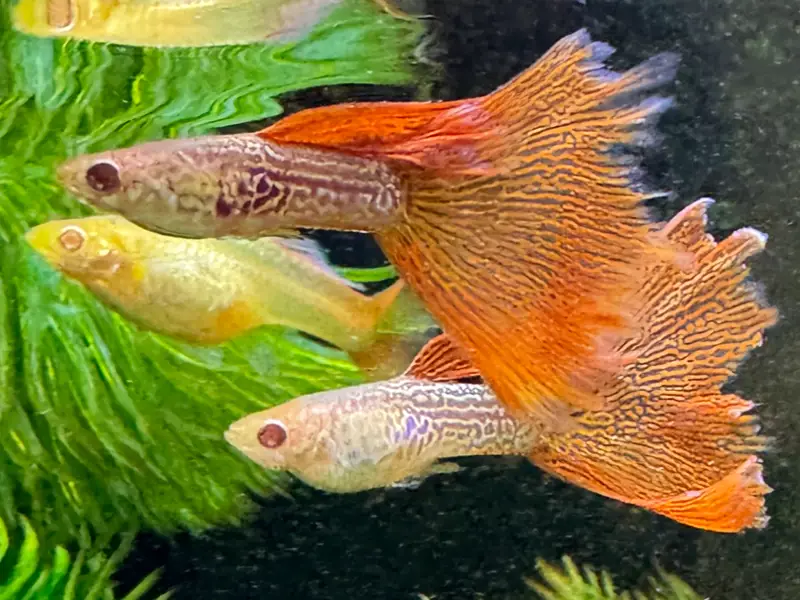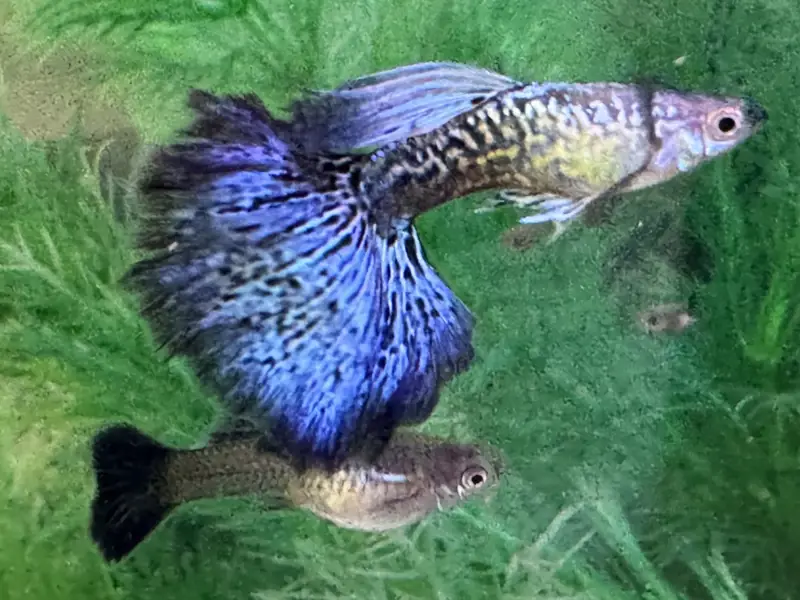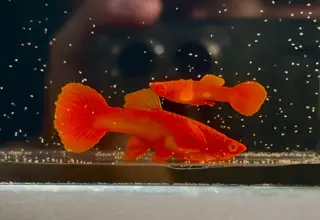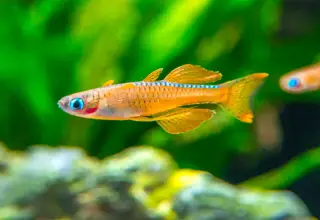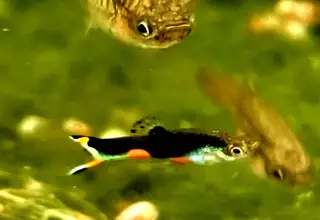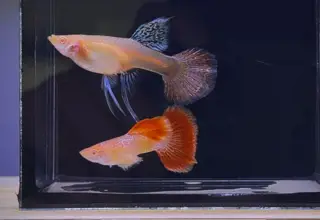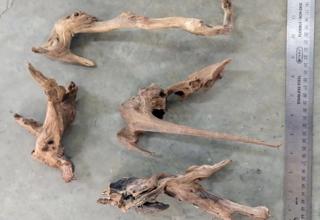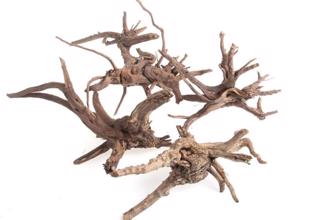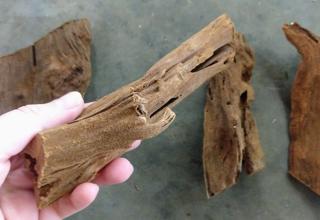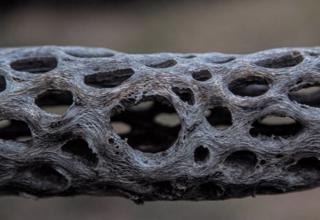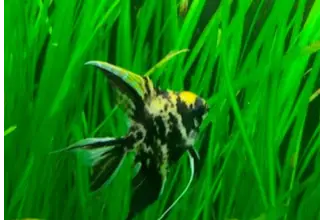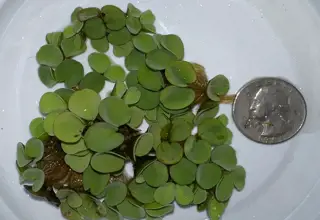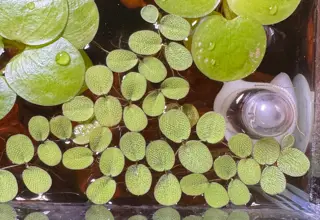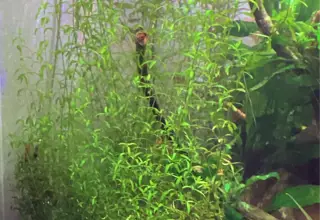Cherry Shrimp: Care, Where to Purchase & More
Posted by on 9/04/2023
Arguably one of the most commonly seen freshwater inverts is known as the Red Cherry, or simply Cherry Shrimp. The species is widely popularized for its ease of care, algae-eating abilities, and striking appearance. The species has even landed on our list of 10 Best Freshwater Shrimp for Beginners.
However, hobbyists looking to add one of these small-sized shrimp to their tanks should be aware that they present unique care challenges for those used to caring exclusively for freshwater fish.
In this post, we'll cover everything needed to decide whether or not a cherry shrimp should be your next tank addition, and we'll even recommend some highly rated vendors where you can order these fascinating shrimp online.
January's Giveaways on Light Fish
Species Summary
Cherry shrimp (scientific name: Neocaridina davidi) hail from eastern China and the northern parts of Taiwan, where they live in slow-to-moderate moving streams and feed on biofilm, small groupings of microorganisms that can exist on biological and non-biological surfaces.
Aquarists who have studied the history of the species may already be familiar with its scientific name change. The species was originally classified as Neocaridina davidi, re-classified as Neocaridina heteropoda, and then re-classified yet again as Neocaridina davidi by French carcinologist Eugène Louis Bouvier .
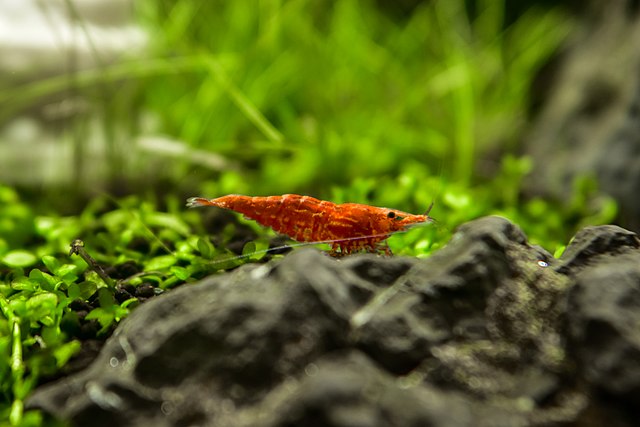
Appearance
Hobbyists may be surprised to know that the species's natural coloration varies between green and brown, and it is the result of decades of crossbreeding that has produced the vibrant red coloration seen in these shrimp today.
However, don't be surprised if your local aquarium store doesn't offer cherry shrimp with the vibrant red coloration seen on social media websites such as Instagram. Any Neocaridina davidi that exhibits a hint of red coloration is labeled a cherry shrimp, but the most sought-after feature is a bright red coloration with little-to-no transparency. The complexities of the coloration have resulted in the species having their own grading system.
Besides their color, these shrimp sport an appearance similar to other invertebrates that fall under the Caridea Infraorder . 2 long antennae extend in the front of the shrimp, which are used to allow the shrimp to "smell" and "taste" things through the water column. 5 pairs of walking legs extended beneath the carapace, the area of the shrimp that surrounds the eye. Directly behind the carapace is the abdomen, below which sit 5 pairs of swimmerets, small appendages that the shrimp can use to swim. Behind the abdomen lies the Uropod, the scientific name for the shrimp's tail.
Size
Newborn Cherry Shrimp are about the size of the tip of a ballpoint pen, and adults will only grow to be about 1.25 inches in length.
1.25 inches is a typical size for most freshwater shrimp seen in the hobby, only surpassed by the slightly larger Ghost Shrimp .
Male vs Female
The main difference between male and female cherry shrimp is that males tend to be a bit smaller and have a flat midsection, compared to females that are a bit larger and have rounded stomachs (for carrying eggs.)
Males tend to be less opaque in coloration compared to females, but this may vary depending on the breed.
Grading System
Cherry shrimp are often valued and referred to by their grade, a subjective grading system aimed at classifying the appearance of crossbred cherry shrimp.
In most cases, the following is a good standard to follow.
SSS grade, also known as Painted Fire Reds. Shrimp in this category are completely opaque, and their legs are also red. The opacity is so strong that hobbyists will even have trouble seeing the eggs on the midsection of a pregnant painted fire red.
SS grade, also known as Fire Cherrys. These shrimp are similar to Painted Fire Reds, except that pregnant females will have some transparency around their midsection
S grade, also known as Sakura. These shrimp are mostly opaque. Typically you'll see transparency in the legs and maybe a few spots of transparency throughout the body.
A/B grade, standard cherry. These are the most commonly seen cherry shrimp and have lots of transparency throughout the body. They are the cheapest of the grades and are often found at brick-and-mortar local fish stores.
Rili cherry. These cherries have a red-colored body with a transparent band around the midsection. These shrimp are quite rare and often pursued by hobbyists who appreciate the transparent coloration.
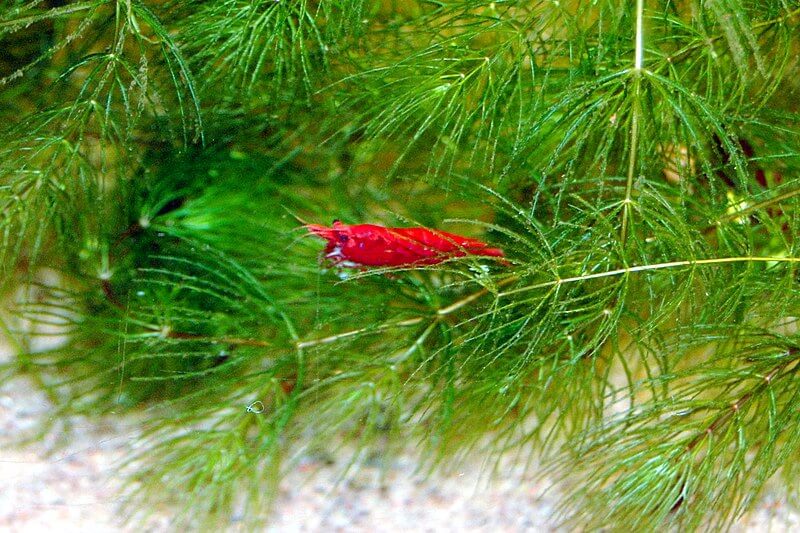
Cherry Shrimp Care
Cherry shrimp are some of the easiest to care for invertebrates for beginners. Still, hobbyists new to shrimp keeping should have a strong understanding of the species's care requirements before making a purchase.
Let's dig into some of the basics so that your Cherry Shrimp can reach their full life expectancy.
Lifespan
When provided with a pristine environment and a nutrient-rich diet, Cherry Shrimp should live for about 2 years in captivity.
Cherry shrimp are a relatively short-lived species, but fortunately for hobbyists, they breed easily, making it possible to sustain a long lineage of cherry shrimp in a single aquarium.
Tank Size
Cherry shrimp don't require much in terms of tank size, and can thrive in aquariums as small as 2.5 gallons
Due to their small size, hobbyists should have no issues keeping them in nano-sized or large tanks. Some of the most award-winning aquascapes in the freshwater hobby have featured cherry shrimp in tanks larger than 100 gallons in size.
Acclimation
As with any new species you plan on adding to your aquarium, you should always acclimate new tank additions slowly over 1 hour, so that they can adjust to your tank's water chemistry.
One of the best tools for the job is a drip acclimation kit . But for those that don't have one of these kits handy, they can use the following methods.
- Release the shrimp and the water they're being transported in, into a bucket.
- Slowly add 3-5% of your tank water to the bucket.
- Keep adding 3-5% of your tank water into the bucket every 10 minutes over 1 hour.
- Once you've added enough tank water, you can release the cherry shrimp into your tank.
While experienced hobbyists may skip the acclimation step, we strongly recommend doing so. Releasing cherry shrimp into your tank without acclimating lowers their survival rate. Luckily for hobbyists, cherry shrimp are some of the hardiest inverts, leaving some room for error when it comes to acclimation.
🛒 Shop Freshwater Fish on Light Fish
Water Conditions
Cherry shrimp are capable of adapting to a wide range of water conditions given an acceptable acclimation period. If you plan on adding cherry shrimp to your tank, you'll want to make sure that your tank is fully cycled. Assuming they're being introduced into a mature aquarium, you'll want to aim for the following water parameters:
Temperature Range: 65°F-80°F
pH: 6.5-8
Ammonia: 0ppm
Nitrite: < .2ppm
Nitrate: < 10ppm
GH: 7-14 dGH
KH: 3-7 dKH
Maintain these water parameters for the duration of your shrimp's life. When performing water changes, always perform them slowly over a 30-60 minute period, so that you don't "shock" your cherry shrimp with a sudden swing in water chemistry.
Tank Setup
When preparing an aquarium to house cherry shrimp, you'll want to provide plenty of live aquatic plants and hardscape, such as driftwood and stone. Some of our favorite aquatic plants include anubias frazeri, rotala h'ra, and taiwan lilies, but virtually any aquatic plant will do.
Driftwoods such as Mopani, Cholla, and Malaysian all look great in a cherry shrimp tank. Stones such as dragon stone and seiryu can be incorporated into an aquascape featuring cherry shrimp, but hobbyists should keep in mind that certain stones, such as seiryu stone aquascapes can slowly raise pH levels over time.
Hobbyists who are running planted tanks with injected CO2 should keep a close eye on their CO2 drop checkers. Invertebrates, including Cherry Shrimp, are sensitive to sudden changes in water chemistry, and since injecting CO2 lowers pH, hobbyists should reduce their CO2 injection rate for a few days until their shrimp have fully adapted to the pH drop in a CO2-injected tank.
Hobbyists that plan on keeping cherry shrimp in an aquarium with fish, such as blue emperor tetras or purple moscow guppies should have plenty of hiding spots available for red cherries. Their small size makes them susceptible to bullying from other livestock, but when hiding spots are provided, they'll establish an area of refuge so that their community can thrive!
We also strongly recommend a heater, a filter rated for your tank size, and a substrate suitable for cherry shrimp.
Common Diseases
One of the most common diseases that affects cherry shrimp is known as Vorticella, and its symptoms are characterized as a fungus-like growth that grows on the body of cherry shrimp. Natural remedies include Aquarium Salt, which requires the shrimp to be dipped in 1-cup tank water:1-teaspoon aquarium salt mixture. After which the shrimp should be transferred into an established, fully-cycled quarantine tank, where it should be closely monitored.
Treatment should be repeated until symptoms clear up.
While diseases in cherry shrimp are uncommon, they tend to have the same root cause: lack of care. Prevention is the best cure for treating diseases that affect cherry shrimp, and hobbyists should perform regular water changes while frequently testing their water chemistry. Doing so will keep your cherry shrimp's immune system in tip-top shape so that they can naturally prevent these diseases from taking hold.
Food & Diet
Cherry shrimp should be fed a nutrient-rich diet of algae wafers and sinking pellet food at least 1-2 times per day.
In the wild, cherry shrimp regularly graze on biofilm, and hobbyists will greatly benefit from their algae-eating abilities in captivity. If your aquarium consistently has available algae, these shrimp will have enough food to survive, but supplementing their diet with regular feedings will allow them to produce their brightest colors.
Behavior and Temperament
Cherry shrimp are an incredibly peaceful species and will show virtually zero aggression towards other tank mates. They spend most of their day cruising around the aquarium looking for new food sources. When they're not grazing on algae, they can be found lounging among foliage or hiding out in established hiding spots.
Pregnant cherry shrimp tend to be a bit more reclusive, but can still be found foraging around the tank. Due to their active personalities, cherry shrimp are often the center of attention in an established tank.
Molting
Hobbyists new to keeping shrimp may be a bit confused when they come across their first exoskeleton. Cherry shrimp, similar to many types of invertebrates, will frequently shed their exoskeletons. The process happens quickly and is a rare event to see in person.
After a successful molt, cherry shrimp will leave behind their transparent, calcium-rich exoskeletons that will eventually break apart in the water column.
Hobbyists can leave the exoskeletons in their tank and should show no signs of concern, as molting is one of the best indicators that your cherry shrimp are in perfect health.
🛒 Shop Aquarium Plants Fish on Light Fish
Tank Mates
Due to their peaceful temperament, hobbyists have plenty of great tank mate options to choose from. The best tank mates for red cherry shrimp are more cherry shrimp, as they do best when kept in groups of 5 or more. Hobbyists interested in cross-breeding the species can combine red cherries with other Neocardinia davidi color morphs, such as the Orange Pumpkin and Blue Dream.
Some of our favorites include:
-
Neon Tetras
-
Cardinal Tetras
And many more nano schooling fish.
Avoid aggressive fish, such as Cuban Cichlids, Red Dragon Flowerhorns, and Electric Blue Jack Dempseys, all of which may mistake cherry shrimp as a snack.
Breeding
Cherry shrimp breed readily and frequently in captivity. There is very little a hobbyist needs to do to encourage spawning besides raising temperatures by a few degrees and maintaining pristine water conditions. Providing plenty of hiding spots in an aquarium will also encourage breeding, but the most difficult step in the breeding process will be raising the baby shrimplets.
Due to their small size, baby shrimp will be viewed as a food source by virtually every freshwater fish. Hobbyists considering breeding cherry shrimp should have a dedicated breeding tank so that these shrimp can grow into adults safe from predation.
The breeding tank should have plenty of surface area with algae for the shrimplets to feed upon. If no algae is present, an algae wafer can be added. Hobbyists should make sure that food waste does not accumulate to the point where it increases ammonia in the tank. To maintain stability in a breeding tank, hobbyists can slowly perform 10% water changes over 30 minutes every 2-3 days.
Typically, juvenile cherry shrimp will reach their full adult size at around the 2.5-month mark. After which they can be introduced back into a hobbyist's display tank. Pregnant cherries are capable of producing dozens of offspring, which you can enjoy in your main tank, or sell to local fish stores or list for sale on our marketplace.
Where to Purchase
Hobbyists looking to pick up low-grade or high-grade cherries can purchase from trusted online vendors such as:
-
The Shrimp Farm: https://www.theshrimpfarm.com/
-
The Shrimp Tank: https://www.theshrimptank.com/
-
Planet Inverts (Lundgren Aquatic Biology): https://lundgrenaquaticbiology.com/store
-
I Wet My Plants: https://iwetmyplantsaquatics.com/
-
Daku Aquatics: https://www.dakuaquatics.com/
When purchasing livestock online, it's important to determine the shipping origin location, so that any delays in shipment can be circumvented as best as possible.
If you're looking to find a reputable shrimp breeder in your area, we built a massive list of over 250 online aquarium stores 👀 that you can use to find vendors local to your area.
Conclusion
As you can see, cherry shrimp are an aquarium staple. Whether you're looking to add these shrimp to your tank for their aesthetic appearance or their algae-eating abilities, cherry shrimp are an absolute joy to observe and care for.
Now that we've covered the ins and outs of keeping these shrimp, do you plan on adding some to your tank? Let us know in the comments, and be sure to check out our marketplace, where you can purchase cherry shrimp directly from hobbyists and small businesses.
January's Giveaways on Light Fish
